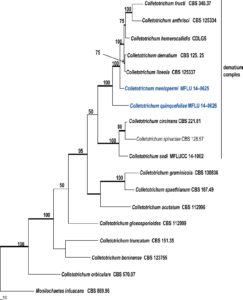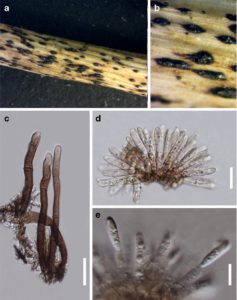Colletotrichum menispermi Chethana, Jayawardena, Bulgakov & K.D. Hyde, sp. nov., Index Fungorum number: IF 551744
Etymology: The specific epithet menispermi is named after the host genus Menispermum from which the taxon was collected.
Saprobic on dead twigs of Menispermum dauricum DC. Sexual morph Undetermined. Asexual morph Conidiomata 180–265μm (x = 229μm, n = 10) diam., solitary, acervulus, black, oval. Setae 59–109μm long, pale to dark brown, smooth-walled, straight, 2–3-septate, base cylindrical, 4–9 μm diam. and rounded apex. Conidiophores simple, to 33 μm long, hyaline to pale brown, smooth-walled. Conidiogenous cells reduced. Conidia 6–18 × 2–5 μm (x = 12 × 4 μm, n = 20), L/W ratio 3.0, hyaline, aseptate, smooth-walled, both sides gradually tapering towards the round to slightly acute apex, truncate base and guttulate. Appresoria not observed.
Material examined: RUSSIA, Rostov region, Rostov-on- on city, Botanical Garden of Southern Federal University,
introductional nursery, on dead twigs of Menispermum dauricum (Menispermaceae), 5 March 2014, T.S. Bulgakov,
(MFLU 14–0625, holotype), (isotype in GZAAS, under the code of GZAAS 15–0102).
Note: Based on phylogenetic analyses and morphological comparison Colletotrichum menispermi clusters in the Colletotrichum dematium species complex, forming a separate.
Fig. 1 Phylogram generated from parsimony analysis based on combined ITS, GADPH, CHS, ACT and β-tubulin sequence data of Colletotrichum. Parsimony bootstrap support values greater than 50 % are indicated above or below the nodes, and branches with Bayesian posterior probabilities greater than 0.95 are given in bold. The ex-type strains are in bold; the new isolates are in blue. The tree is rooted with Monilochaetes infuscans CBS 869.96.

Fig. 2 Phylogram generated from parsimony analysis based on combined ITS, GADPH, CHS, ACT and β-tubulin sequence data of Colletotrichum. Parsimony bootstrap support values greater than 50 % are indicated above or below the nodes, and branches with Bayesian posterior probabilities greater than 0.95 are given in bold. The ex-type strains are in bold; the new isolates are in blue. The tree is rooted with Monilochaetes infuscans CBS 869.96.

